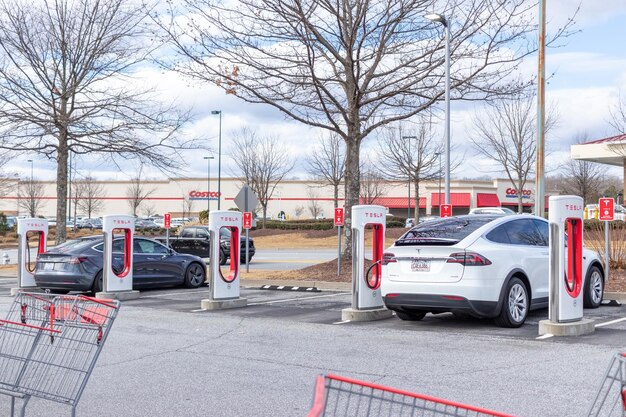Electric Vehicle Sales Surge: Impact on US Auto Dealerships by 2025

The projected 15% increase in electric vehicle (EV) sales by 2025 is poised to significantly impact US auto dealerships, requiring them to adapt their business models, infrastructure, and sales strategies to cater to the growing demand for EVs.
The automotive industry is on the cusp of a significant transformation, with electric vehicles leading the charge. The projected 15% increase in electric vehicle sales by 2025 is set to send ripples throughout the US auto dealership landscape. How are dealerships preparing for this electric future, and what challenges and opportunities lie ahead?
Understanding the Electric Vehicle Market Growth
The electric vehicle (EV) market is experiencing unprecedented growth, driven by factors such as environmental concerns, government incentives, and advancements in battery technology. As EVs become more affordable and offer longer ranges, their adoption rate is accelerating.
Factors Driving EV Sales
Several key factors are contributing to the rise in EV sales, creating a perfect storm for the automotive industry. Understanding these drivers is essential for dealerships to capitalize on the growing demand.
- Environmental Awareness: Consumers are increasingly concerned about the environmental impact of gasoline-powered vehicles, making EVs an attractive alternative.
- Government Incentives: Federal, state, and local incentives, such as tax credits and rebates, are making EVs more affordable.
- Technological Advancements: Improvements in battery technology have increased EV range and reduced charging times, addressing key consumer concerns.
This surge in EV popularity directly influences how auto dealerships operate, necessitating adjustments in their traditional business models to accommodate and promote these vehicles effectively.
Adapting Dealership Infrastructure for EVs
One of the most significant challenges facing US auto dealerships is adapting their infrastructure to accommodate EVs. This includes installing charging stations, training staff on EV maintenance and repair, and updating service bays to handle EV-specific needs.

Charging Infrastructure Needs
Dealerships need to invest in installing charging stations to support EV sales and service. The type and number of charging stations required will depend on factors such as the dealership’s size, location, and the types of EVs it sells.
- Level 2 Chargers: These chargers can fully charge an EV in 4-8 hours and are suitable for customers who want to top off their batteries while shopping or waiting for service.
- DC Fast Chargers: These chargers can provide a significant charge in as little as 30 minutes, making them ideal for quick top-ups and attracting customers who need a fast charge.
- Smart Charging Systems: Implementing smart charging systems can help manage energy consumption and optimize charging schedules, reducing costs and maximizing efficiency.
Adapting the infrastructure is crucial to ensuring dealerships can cater to the needs of EV owners, providing them with convenient charging options and expert service.
Training and Expertise for EV Sales and Service
Selling and servicing EVs requires a different skillset than traditional gasoline-powered vehicles. Dealerships need to invest in training their staff on EV technology, sales techniques, and maintenance procedures.
Upskilling Dealership Personnel
Training programs should cover topics such as EV battery technology, charging systems, regenerative braking, and other EV-specific features. Sales staff need to be able to effectively communicate the benefits of EVs to customers and address their concerns.
Technicians need specialized training to diagnose and repair EVs safely and effectively. This includes learning how to work with high-voltage systems and using specialized diagnostic tools.
Investing in comprehensive training ensures that dealerships can provide top-notch service and build customer confidence in their EV offerings.

Marketing and Selling EVs Effectively
Marketing EVs requires a different approach than traditional gasoline-powered vehicles. Dealerships need to highlight the benefits of EVs, such as lower running costs, environmental friendliness, and advanced technology.
Showcasing EV Advantages
Dealerships can use a variety of marketing channels to reach potential EV buyers, including online advertising, social media, and community events. Emphasizing real-world cost savings, such as reduced fuel and maintenance expenses, can be highly persuasive.
Offering test drives and showcasing the latest EV technology can help customers experience the benefits of EVs firsthand. Dealerships should also be prepared to answer common questions and address concerns about EV range, charging, and battery life.
Effective marketing and customer education are key to driving EV sales and building a loyal customer base.
Financial Implications and Profitability
The transition to EVs can have significant financial implications for auto dealerships. While EVs may require lower maintenance, dealerships need to adapt their revenue streams and explore new profit opportunities.
Revenue Stream Diversification
Dealerships may need to rely more on service contracts, parts sales, and software updates for EVs. Offering charging services to the public can also generate additional revenue. As EVs become more prevalent, dealerships can explore partnerships with energy providers and charging network operators.
Additionally, the higher upfront cost of EVs can lead to larger financing deals, potentially increasing finance and insurance (F&I) revenue. Dealerships need to adapt their business models to thrive in the evolving EV landscape.
By exploring new revenue streams and adapting their financial strategies, dealerships can ensure profitability in the age of EVs.
Navigating Policy and Regulatory Changes
Government policies and regulations play a significant role in the EV market. Dealerships need to stay informed about changes in incentives, emission standards, and other regulations that could impact EV sales and adoption.
Staying Informed
Dealerships should actively engage with industry associations and government agencies to stay abreast of the latest developments. Advocating for policies that support EV adoption can help create a more favorable market environment. Understanding and complying with relevant regulations is essential for maintaining compliance and maximizing opportunities.
Dealerships that proactively navigate policy and regulatory changes will be better positioned to succeed in the evolving EV market.
| Key Point | Brief Description |
|---|---|
| ⚡ Charging Infrastructure | Dealerships must invest in Level 2 and DC Fast Chargers to support EV sales and customer needs. |
| 🧑🔧 Staff Training | Training sales and service staff on EV technology and maintenance is crucial. |
| 📣 Marketing EVs | Highlighting the cost savings and environmental benefits of EVs is important for attracting customers. |
| 💰 Revenue Diversification | Exploring new revenue streams such as service contracts and charging services can boost profitability. |
Frequently Asked Questions
▼
Traditional dealerships will need to adapt by investing in infrastructure, training staff, and adjusting sales and service strategies to accommodate EVs. The shift requires significant changes.
▼
Dealerships need to install charging stations, update service bays to handle EV-specific repairs, and ensure proper disposal of EV batteries. This requires both capital and space.
▼
Dealerships can offer training programs focused on EV technology, sales techniques, and specialized maintenance procedures. These programs help staff understand and explain EV features.
▼
Highlight lower running costs, environmental benefits, and advanced technology through online advertising, social media, and test drives. Showcasing real-world savings is key.
▼
Dealerships can generate income through service contracts, software updates, parts sales, and offering charging services to the public. Partnerships with energy providers are also potential.
Conclusion
The projected increase in electric vehicle sales by 2025 presents both challenges and opportunities for US auto dealerships. By adapting their infrastructure, training their staff, and embracing new marketing strategies, dealerships can successfully navigate the transition to an electric future and capitalize on the growing demand for EVs.





